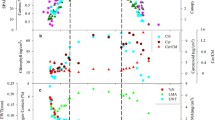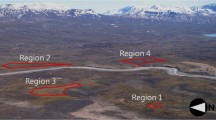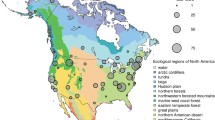Abstract
Understanding relationships between canopy structure and the seasonal dynamics of photosynthetic uptake of CO2 by forest canopies requires improved knowledge of canopy phenology at eddy covariance flux tower sites. We investigated whether digital webcam images could be used to monitor the trajectory of spring green-up in a deciduous northern hardwood forest. A standard, commercially available webcam was mounted at the top of the eddy covariance tower at the Bartlett AmeriFlux site. Images were collected each day around midday. Red, green, and blue color channel brightness data for a 640 × 100-pixel region-of-interest were extracted from each image. We evaluated the green-up signal extracted from webcam images against changes in the fraction of incident photosynthetically active radiation that is absorbed by the canopy (f APAR), a broadband normalized difference vegetation index (NDVI), and the light-saturated rate of canopy photosynthesis (A max), inferred from eddy flux measurements. The relative brightness of the green channel (green %) was relatively stable through the winter months. A steady rising trend in green % began around day 120 and continued through day 160, at which point a stable plateau was reached. The relative brightness of the blue channel (blue %) also responded to spring green-up, although there was more day-to-day variation in the signal because blue % was more sensitive to changes in the quality (spectral distribution) of incident radiation. Seasonal changes in blue % were most similar to those in f APAR and broadband NDVI, whereas changes in green % proceeded more slowly, and were drawn out over a longer period of time. Changes in A max lagged green-up by at least a week. We conclude that webcams offer an inexpensive means by which phenological changes in the canopy state can be quantified. A network of cameras could offer a novel opportunity to implement a regional or national phenology monitoring program.






Similar content being viewed by others
References
Ahl DE, Gower ST, Burrows SN, Shabanov NV, Myneni RB, Knyazikhin Y (2006) Monitoring spring canopy phenology of a deciduous broadleaf forest using MODIS. Remote Sens Environ 104:88–95
Badeck F-W, et al. (2004) Responses of spring phenology to climate change. New Phytol 162:295–309
Baldocchi D, et al. (2001) FLUXNET: a new tool to study the temporal and spatial variability of ecosystem-scale carbon dioxide, water vapor, and energy flux densities. Bull Am Meteorol Soc 82:2415–2434
Baldocchi DD, et al. (2005) Predicting the onset of carbon uptake by deciduous forests with soil temperature and climate data: a synthesis of FLUXNET data. Intl J Biometeorol 49:377–387
Bassow SL, Bazzaz FA (1998) How environmental conditions affect canopy leaf-level photosynthesis in four deciduous tree species. Ecology 79:2660–2675
Betancourt JL, et al. (2005) Implementing a U.S. National phenology network. EOS Trans 86:539–541
Chuine I, Yiou P, Viovy N, Seguin B, Daux V, Le Roy Ladurie E (2004) Grape ripening as a past climate indicator. Nature 432:289–290
Churkina G, Schimel D, Braswell BH, Xiao XM (2005) Spatial analysis of growing season length control over net ecosystem exchange. Global Change Biol 11:1777–1787
Drolet GG, et al. (2005) A MODIS-derived photochemical reflectance index to detect inter-annual variations in the photosynthetic light-use efficiency of a boreal deciduous forest. Remote Sens Environ 98:212–224
Fisher JI, Mustard JF, Vadeboncoeur MA (2006) Green leaf phenology at Landsat resolution: scaling from the field to the satellite. Remote Sens Environ 100:265–279
Fitter AH, Fitter RSR (2002) Rapid changes in flower time in British plants. Science 296:1689–1691
Gamon JA, Serrano L, Surfus JS (1997) The photochemical reflectance index: an optical indicator of photosynthetica radiation use efficiency across species, functional types, and nutrient levels. Oecologia 112:492–501
Gates DM (1966) Spectral distribution of solar radiation at the Earth’s surface. Science 151:523–529
Goulden ML, Munger JW, Fan SM, Daube BC, Wofsy SC (1996) Measurements of carbon sequestration by long-term eddy covariance: methods and a critical evaluation of accuracy. Global Change Biol 2:169–182
Hill MJ, Held AA, Leuning R, Coops NC, Hughes D, Cleugh HA (2006) MODIS spectral signals at a flux tower site: Relationships with high-resolution data, and CO2 flux and light use efficiency measurements. Remote Sens Environ 103:351–368
Hollinger DY, Richardson AD (2005) Uncertainty in eddy covariance measurements and its application to physiological models. Tree Physiol 25:873–885
Hollinger DY, Goltz SM, Davidson EA, Lee JT, Tu K, Valentine HT (1999) Seasonal patterns and environmental control of carbon dioxide and water vapour exchange in an ecotonal boreal forest. Global Change Biol 5:891–902
Hollinger DY, et al. (2004) Spatial and temporal variability in forest–atmosphere CO2 exchange. Global Change Biol 10:1689–1706
Huemmrich KF, Black TA, Jarvis PG, McCaughey JH, Hall FG (1999) High temporal resolution NDVI phenology from micrometeorological radiation sensors. J Geophys Res Atmos 104:27935–27944
Huete A, Didan K, Miura T, Rodriguez EP, Gao X, Ferreira LG (2002) Overview of the radiometric and biophysical performance of the MODIS vegetation indices. Remote Sens Environ 83:195–213
Jenkins JP, Braswell BH, Frolking SE, Aber JD (2002) Detecting and predicting spatial and interannual patterns of temperate forest springtime phenology in the eastern U.S. Geophys Res Lett 29:2201, doi:2210.1029/2001GL014008
Jenkins JP, Richardson AD, Braswell BH, Ollinger SV, Hollinger DY, Smith ML (2007) Refining light-use efficiency calculations for a deciduous forest canopy using simultaneous tower-based carbon flux and radiometric measurements. Agric For Meteorol 143:64–79
Lieth H (1975) Modeling primary productivity of the world. In: Lieth H, Whittaker RH (eds) Primary productivity of the biosphere, vol 14. Springer, New York, pp 237–263
Lucht W, et al. (2002) Climatic control of the high-latitude vegetation greening trend and Pinatubo effect. Science 296:1687–1689
Moore KE, Fitzjarrald DR, Sakai RK, Goulden ML, Munger JW, Wofsy SC (1996) Seasonal variation in radiative and turbulent exchange at a deciduous forest in central Massachusetts. J Appl Meteorol 35:122–134
Morecroft MD, Stokes VJ, Morison JIL (2003) Seasonal changes in the photosynthetic capacity of canopy oak (Quercus robur) leaves: the impact of slow development on annual carbon uptake. Int J Biometeorol 47:221–226
Nemani RR, et al. (2003) Climate-driven increases in global terrestrial net primary production from 1982 to 1999. Science 300:1560–1563
Oliphant A, Grimmond SCB, Schmid HP, Wayson CA (2006) Local-scale heterogeneity of photosynthetically active radiation (PAR), absorbed PAR and net radiation as a function of topography, sky conditions and leaf area index. Remote Sens Environ 103:324–337
Peñuelas J, Filella I, Comas P (2002) Changed plant and animal life cycles from 1952 to 2000 in the Mediterranean region. Global Change Biol 8:531–544
Qi J, Moran MS, Cabot F, Dedieu G (1995) Normalization of sun/view angle effects using spectral albedo-based vegetation indices. Remote Sens Environ 52:207–217
Qi Y, Bai S, Heisler GM (2003) Changes in ultraviolet-B and visible optical properties and absorbing pigment concentrations in pecan leaves. Agric For Meteorol 120:229–240
Richardson AD, Berlyn GP, Gregoire TG (2001) Spectral reflectance of Picea rubens (Pinaceae) and Abies balsamea (Pinaceae) needles along an elevational gradient, Mt. Moosilauke, New Hampshire, USA. Am J Bot 88:667–676
Richardson AD, Bailey AS, Denny EG, Martin CW, O’Keefe J (2006a) Phenology of a northern hardwood forest canopy. Global Change Biol 12:1174–1188
Richardson AD, et al. (2006b) A multi-site analysis of random error in tower-based measurements of carbon and energy fluxes. Agric For Meteorol 136:1–18
Running SW, Nemani RR (1991) Regional hydrologic and carbon balance responses of forests resulting from potential climate change. Clim Change 19:349–368
Sakai RK, Fitzjarrald DR, Moore KE (1997) Detecting leaf area and surface resistance during transition seasons. Agric For Meteorol 84:273–284
Schaber J (2002) Phenology in Germany in the 20th century: methods, analyses and models. In: Department of Geoecology. University of Potsdam, Potsdam, p 146
Schwartz MD, Reed BC, White MA (2002) Assessing satellite-derived start-of-season measures in the coterminous USA. Int J Climatol 22:1793–1805
Sit V, Poulin-Costello M (1994) Catalog of curve fitting (biometrics information handbook series, no. 4). British Columbia Ministry of Forests, Victoria
Sparks TH, Menzel A (2002) Observed changes in seasons: an overview. Int J Climatol 22:1715–1725
Suni T, et al. (2003) Air temperature triggers the recovery of evergreen boreal forest photosynthesis in spring. Global Change Biol 9:1410–1426
Turner DP, et al. (2003) A cross-biome comparison of daily light use efficiency for gross primary production. Global Change Biol 9:383–395
Wang Q, Tenhunen J, Dinh NQ, Reichstein M, Vesala T, Keronen P (2004) Similarities in ground- and satellite-based NDVI time series and their relationship to physiological activity of a Scots pine forest in Finland. Remote Sens Environ 93:225–237
White MA, Thornton PE, Running SW (1997) A continental phenology model for monitoring vegetation responses to interannual climatic variability. Global Biogeochem Cycles 11:217–234
White MA, Running SW, Thornton PE (1999) The impact of growing-season length variability on carbon assimilation and evapotranspiration over 88 years in the eastern US deciduous forest. Int J Biometeorol 42:139–145
Wilson KB, Baldocchi DD, Hanson PJ (2001) Leaf age affects the seasonal pattern of photosynthetic capacity and net ecosystem exchange of carbon in a deciduous forest. Plant Cell Environ 24:571–583
Wofsy SC, Harriss RC (2002) The North American carbon program (NACP): a report of the NACP Committee of the U.S. carbon cycle science steering group. In: U.S. Global Change Research Program, Washington
Wright IJ, et al. (2004) The worldwide leaf economics spectrum. Nature 428:821–827
Wythers KR, Reich PB, Turner DP (2003) Predicting leaf area index from scaling principles: corroboration and consequences. Tree Physiol 23:1171–1179
Acknowledgements
Bob Evans and Chris Costello are thanked for their assistance with tower operations. Support for this research was provided by the NASA Terrestrial Carbon Program (grant no. CARBON/04–0120-0011) and by the NASA IDS program (grant no. NNG04GH75G). Research at the Bartlett Experimental Forest is supported by the USDA Forest Service’s Northern Global Change program, and tower measurements are partially funded by the USDA Forest Service’s Northern Research Station. Meteorological and radiometric data, as well as CO2 and H2O fluxes, for the Bartlett tower are available at http://www.public.ornl.gov/ameriflux/ subject to AmeriFlux Fair-use policies.
Author information
Authors and Affiliations
Corresponding author
Additional information
Communicated by Russell Monson.
Rights and permissions
About this article
Cite this article
Richardson, A.D., Jenkins, J.P., Braswell, B.H. et al. Use of digital webcam images to track spring green-up in a deciduous broadleaf forest. Oecologia 152, 323–334 (2007). https://doi.org/10.1007/s00442-006-0657-z
Received:
Accepted:
Published:
Issue Date:
DOI: https://doi.org/10.1007/s00442-006-0657-z




